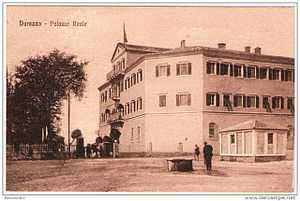Royal Palace of Durrës
| Royal Palace of Durrës | |
|---|---|
| Pallati Mbreteror i Durrësit | |
 The main entrance of the palace. | |
| Alternative names | Konaku i Durrësit |
| General information | |
| Type | Palace |
| Architectural style | Rationalism; Monumental Rationalism |
| Location | Durrës, Albania |
| Address | Bulevardi Epidamn, Durrës (in front of the first port of Durrës Harbor |
| Destroyed | 1926 |
| Client | William, Prince of Albania; Princess Sophie of Schönburg-Waldenburg; Carol Victor, Hereditary Prince of Albania |
The Royal Palace of Durrës or differently known as Konak of Durrës (Albanian: Pallati Mbretëror i Shqipërisë or Konaku i Durrësit) was a royal palace of the Principality of Albania situated in Durrës, Albania. It previously served as the official residence of William, Prince of Albania and his wife Princess Sophie of Schönburg-Waldenburg. It has been used by different Albanian governments for various purposes.
History
The konak in Durrës. This royal residence had been the seat of the Ottoman prefect (mutasarriflik) of Durrës. The three floors of the building with an interior courtyard contained thirty-five rooms. Its facade was ca. 50 metres wide. Prince William arrived in Albania at his capital of Durrës on March 7, 1914 along with the Royal family. King Wied moved into the building five months later and used it as the palace for his six month reign, when furnishing and a modest bevy of servants were brought from Germany. The Palace was raided after the departure of Wied by Muslim Uprising and Haxhi Qamili.
On October 2, 1918 the palace, as the entire city of Durrës was bombed on the orders French Admiral Dominique-Marie Gauchet during the Battle of Durrës. The order was executed by Italian Admiral Paolo Thaon di Revel aboard Dante Alighieri. Gauchet had followed the instructions of General Louis Franchet d'Espèrey, who was serving the Macedonian front on account of the Allies, and according to whom, the Port of Durres, if not destroyed, would have served the evacuation of the Bulgarian and German armies, involved in World War I.[1] The earthquake of 1926 further destroyed the palace and, by 1930, there were no longer any remains.[2]
See also
- Wilhelm of Wied
- Princess Sophie of Schönburg-Waldenburg
- Principality of Albania
- Essad Pasha Toptani
- International Gendarmerie
References
- ↑ Kabashi, Gezim (December 24, 2012). "Fotot e Rralla - Bombardimi i Durresit me 2 Tetor 1918 (English: Rare Photos - Bombing of Durres on October 2, 1918)". Gazeta e Durresit.
- ↑ Brunga, Mark (September 27, 2012). "Urdhri i Shqiponjes se Zeze dekorata e pare e shteti shqiptar". Gazeta e Durresit.
| ||||||||||||||||||||||||||||||||||||||||||||||||||||||
